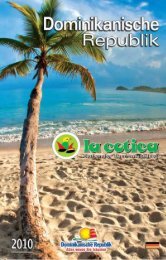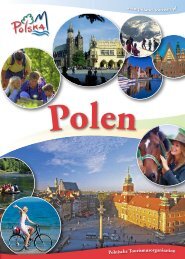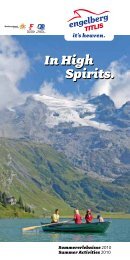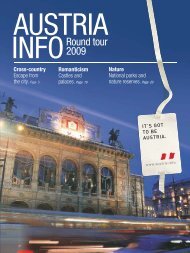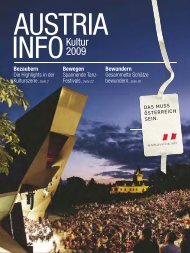i Dominican Republic - travelfilm.de
i Dominican Republic - travelfilm.de
i Dominican Republic - travelfilm.de
You also want an ePaper? Increase the reach of your titles
YUMPU automatically turns print PDFs into web optimized ePapers that Google loves.
Where to go<br />
Our beaches<br />
Perhaps there is no better way of<br />
providing our rea<strong>de</strong>rs with a more<br />
objective appraisal of our beaches than<br />
to borrow the experts below a from<br />
United Nations report on our beaches<br />
and coasts:<br />
“Of all the tourist beaches in the world,<br />
few are blessed with such beautiful<br />
grains of sand or crystal-clear waters. The<br />
beaches are strewn with granules of sand<br />
that are so white that they seem nearly<br />
magical, fantastic. Without question, they<br />
must rank among the best in the world.”<br />
The choice is yours! You may bask in the<br />
magic of our unspoiled, virgin Atlantic<br />
shores to the north. Or you may lull<br />
yourself to won<strong>de</strong>rland with the white<br />
sands of our southern shores, alternately<br />
kissed and teased by the crystalline<br />
waters of the Caribbean Sea.<br />
National parks<br />
Designated and managed as the national<br />
parks system are: urban parks and<br />
recreational areas, natural habitats, and<br />
zoological/botanical reserves where the<br />
country’s flora and fauna are protected.<br />
The Dirección Nacional <strong>de</strong> Parques<br />
(National Parks Office) is the institution<br />
in charge of the <strong>de</strong>velopment,<br />
administration, organization, and<br />
maintenance of all natural and<br />
recreational areas. Its principal objective<br />
46<br />
is to conserve our natural resources<br />
as well as preserve our ecological<br />
patrimony for the perennial enjoyment of<br />
present and future generations.<br />
Recreational areas are ma<strong>de</strong> up of<br />
urban parks, among those in the Santo<br />
Domingo area are: Aquario Nacional<br />
(National Aquarium); Mirador <strong>de</strong>l Norte;<br />
Mirador <strong>de</strong>l Sur; Mirador <strong>de</strong>l Este<br />
(located at the Faro a Colón –[Columbus<br />
Lighthouse]); the Zoológico Nacional<br />
(National Zoo); and the Jardín Botánico<br />
(Botanical Gar<strong>de</strong>ns).<br />
The natural areas and scientific reserves<br />
are composed of, among others: The<br />
J. Armando Bermú<strong>de</strong>z National Parks,<br />
José <strong>de</strong>l Carmen Ariza, Nacional <strong>de</strong>l<br />
Este, Los Haitises, Isla Cabritos, Sierra<br />
<strong>de</strong> Bahoruco, Montecristi and lastly,<br />
Jaragua, which is the largest in the<br />
country, and the Scientific Reserve<br />
Ébano Ver<strong>de</strong>, located in the province<br />
of La Vega, which is representative of a<br />
very wet sub-tropical forest ecosystem,<br />
with an average annual temperature of<br />
12 ºC / 23 ºC.<br />
Here visitors can appreciate the many<br />
species of flora and fauna that are<br />
en<strong>de</strong>mic to our island; see the source<br />
of the Camú and Jatubey rivers; take<br />
a refreshing swim in El Arroyazo, one<br />
of the most important affluent of the<br />
Jimenoa river; enjoy a mountain biking<br />
tour around the surrounding mountains;<br />
go camping in the forest or enjoy a



